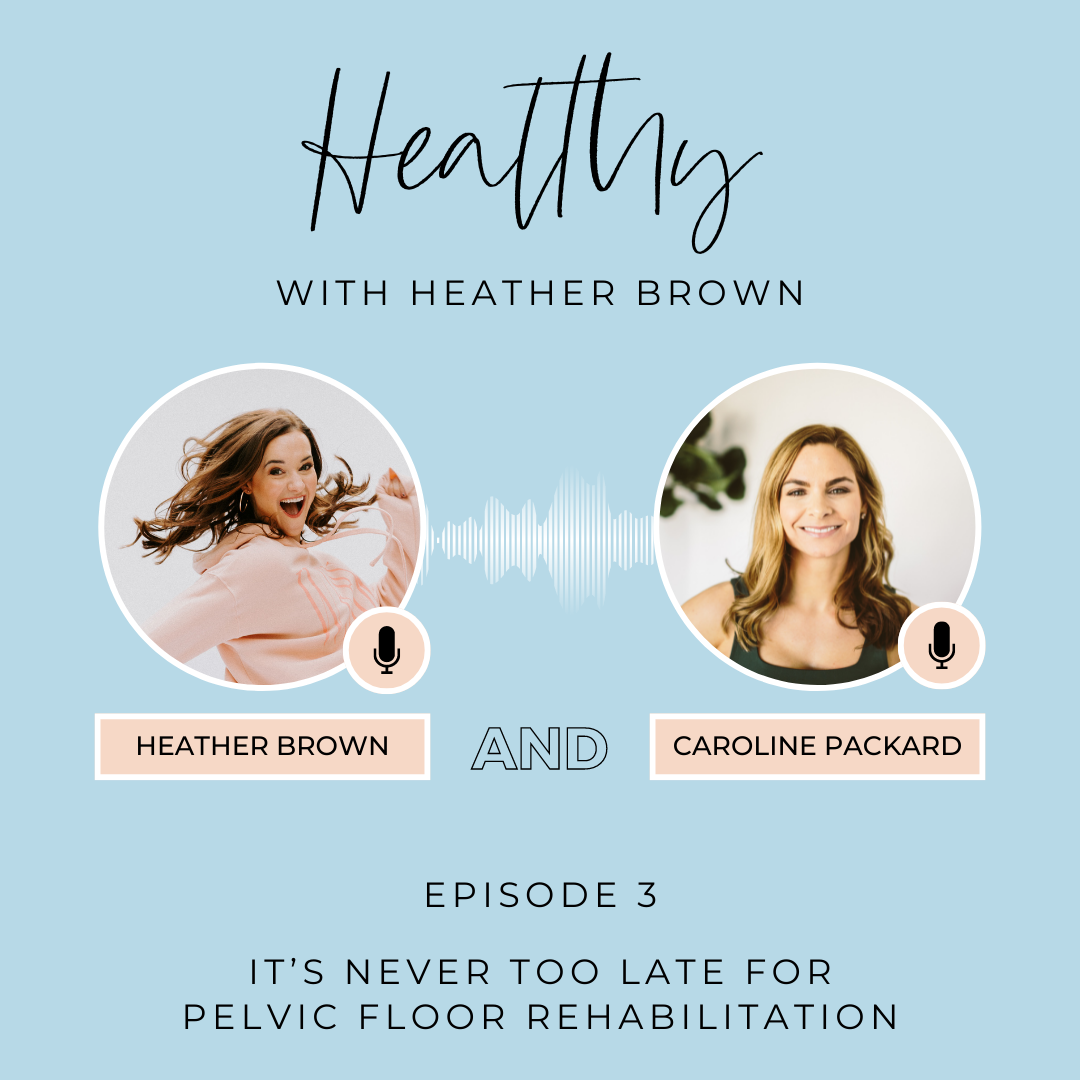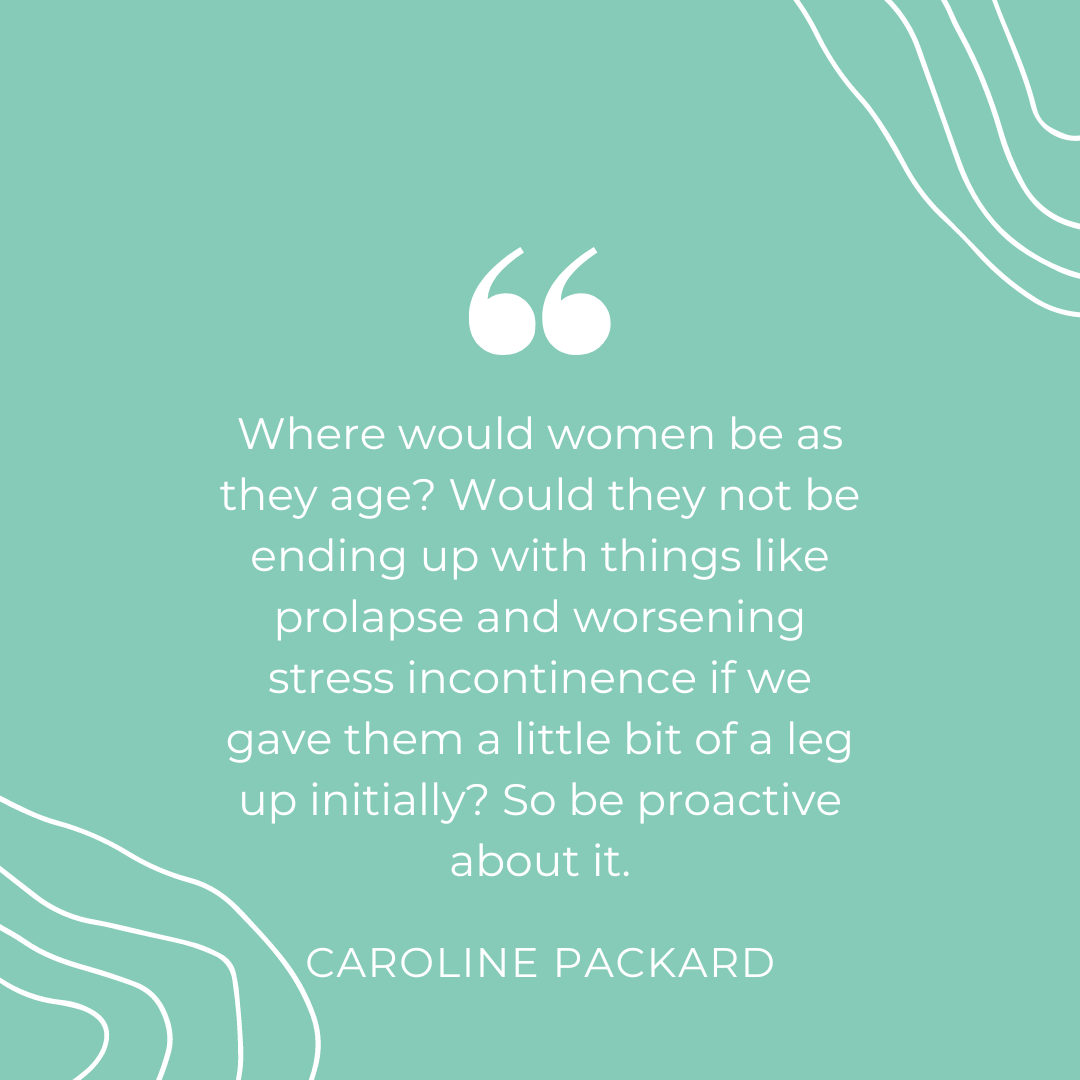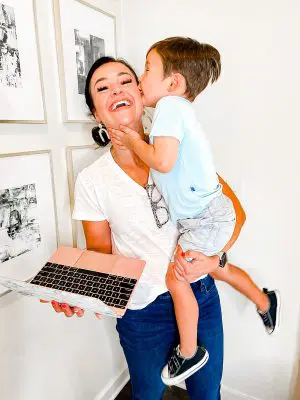Keep scrolling to read the episode show notes from the Pelvic Floor Rehabilitation podcast episode!
CLICK HERE TO LISTEN ON: SPOTIFY | APPLE | STITCHER | OVERCAST | GOOGLE
Get The Full It’s Never Too Late for Pelvic Floor Rehabilitation Show Notes Here:
My guest today is Caroline Packard, who has a doctorate in physical therapy with pelvic floor training. She is also an athlete and a mom of three who has experienced and healed her pelvic floor dysfunction. I’m totally that mom who runs to the bathroom to throw on a panty liner when I find out we’re jumping ropes at the gym. If you can relate, this episode is for you!
In this episode, we discuss:
[1:46] Caroline’s background in physical therapy and pelvic floor health
Caroline has wanted to be a physical therapist from a relatively young age. In high school, she injured herself as a cross country and track runner. She went to physical therapy, and she was amazed by how helpful it was. This experience, combined with her interest in biology in physiology, made physical therapy the perfect career path.
When she had her own children, she found pelvic floor physical therapy. She had pelvic floor issues after the birth of her first baby, which led her on a professional journey. Caroline dove headfirst into continuing education, and she gobbled up everything she could read about pelvic floor dysfunction. Through this process, she learned so much that women should know in order to help themselves. We don’t have to live and struggle with a lot of things that are common, but not normal. These things might happen after childbirth, but they can happen to women who have not had children as well.
[3:06] Factors related to pelvic floor dysfunction
Young athletes may struggle with stress incontinence, such as the involuntary loss of urine during sporting activities. This is common in gymnastics, running, and CrossFit. While many demonize the sports themselves, Caroline says we need to teach athletes a different mechanism for using their muscles and their breath. She sees us setting up young athletes to experience pelvic floor issues later in life, perhaps because they have existed since a young age and are exacerbated once they have children.
[3:59] How to control our muscles and our breath to improve pelvic floor symptoms
Caroline shares the importance of learning to breathe in the right way. Before you even throw exercise into the mix, you need to learn how to diaphragm breathe. She shares a ton about this on her Instagram, as it is not natural to us and it can be a challenge to retrain something that we don’t often think about.
Initially, you need to lay on your back for five minutes and think about whether you breathe in your chest or in with your diaphragm. This is important because the diaphragm is like an umbrella above the pelvic floor. They work together to lengthen and contract the pelvic floor, and when we can contract and lift the pelvic floor effectively then we can work on strengthening and combating prolapse or leaking during exercise.
In addition, applying those concepts to exercise and exhaling on exertion will connect the pelvic floor to lift and minimize impact. Minimizing impact will minimize leaking, as well.
[5:38] Caroline’s athletic training
Caroline is a lifelong runner, but she had to change her workout routine after she had kids. She no longer had the time to go out and run eight miles, and she experienced pelvic floor issues when running after the birth of her first child. As a result, she transitioned to and found the value in strength training. She also loves yoga.
[6:53] How having children changes our perspectives on our bodies
Caroline recalls how active she was in her twenties, and she appreciated that more after having her children and not being able to run without leaking. Running is a physical activity, but many people also find exercise to be emotionally fulfilling. It was a hard hit for her to have to limit her running, and it awakened the idea that we only have one body and one life to live. Putting time into taking care of it is so worth it.
In addition, Caroline learned more about the mental/physical connection and how those two aspects feed off each other. As someone with three kids, a husband, and a busy job, Caroline needs to pour into herself physically and emotionally through that movement to be able to take care of everybody else. She encourages women not to give up on fitness, as making the time for yourself will allow you to give more in other areas of your life.
[9:52] Incontinence after having a baby
Just because incontinence is common after having a baby, that does not make it normal. Pregnancy and childbirth do not have to be connected with avoiding movement and risking leakage. With proper care, you can feel fit and healthy after having kids.
[11:46] Changes in mind/body connection after having children
On the scientific level, regulating our breathing can help to regulate stress. Breathing in our chests is associated with fight or flight mode, whereas diaphragm breathing relaxes the nervous system. Clenching your jaw and other unconscious ways of holding tension can resonate in the pelvic floor and contribute to symptoms there as well. Checking in with your stress level is so important.
On an emotional level, pregnancy and the associated body changes can be very humbling and challenging. It can be a struggle to get your body back to where you want it to be. Caroline believes that working through her pelvic floor dysfunction, however, allowed her to really reconnect with her body. She had to be conscious of her breath, and she became so much more in tune with her body. When you tune in, you can listen to what your body really needs. Caroline now listens to her body, and decides whether she needs to run or do yoga, for example.
In addition, pregnancy physically affects our ability to do that good diaphragm breathing. The belly moves up and pushes our ribs out, and we won’t naturally fall back into breathing that way. People frequently become frustrated when they realize they are breathing incorrectly, but the turning point is when you can stop yourself, take those diaphragm breaths, and tap into that relaxation. You see changes when you can acknowledge that you have fallen back into a bad habit and correct it.
[19:57] How we can care for our pelvic floor
The pelvic floor is a bowl at the bottom of the canister of your upper body. Just below it is a network of muscles that creates a sling or a hammock, supporting your organs of reproduction, bladder, bowel, and sexual intimacy. It is also a sump pump to keep everything moving. It’s pretty darn important when it comes to allowing all of those functions to happen naturally.
The number one way to care for the pelvic floor is to learn how to breathe and to feel where your pelvic floor is. Learning proper bowel and bladder habits is also very important. If you aren’t having a bowel movement daily, that can create a cascade of events including bladder leakage, back pain, and abdominal pain.
If someone is struggling to have regular bowel movements, Caroline tries to figure out why. Are they moving enough? Drinking enough water? Getting enough fiber (25-30 grams/day)? After that, they discuss a magnesium supplement – usually magnesium citrate. This helps to calm the nervous system and relax the smooth muscle of the intestine for a bowel movement. You normally take that supplement in the evening, and as a bonus it also helps you to relax for sleep. Most people are deficient in magnesium because our soils are deficient, and it is a completely safe thing to add in. Creating easier bowel movements can significantly help prolapse, back pain, and diastasis recti. Caroline also talks to her patients about how to breathe properly for a bowel movement.
Caroline also points out that you do not have to have kids to have pelvic floor issues. Some of the lesser known issues associated with pelvic floor dysfunction are constipation and bloating (which tends to happen postpartum if you have diastasis recti). It can also be related to foot issues, because the hip joint connects near the pelvic floor. If you are misaligned at the hip, it can cause foot issues, chronic hip pain, sacrum issues, lower back pain, and even neck pain. TMJ, or jaw grinding, is associated with hypertonic pelvic floor, posture, and upper chest breathing. So everything feeds off each other.
[25:49] It is never too late to rehab the pelvic floor
Hormones and muscle mass are changing as we age, and it is never too late to work toward pelvic floor health. Working on these things through physical therapy can help to avoid surgery or other medical interventions that may be unnecessary. Controlling and managing symptoms will increase your confidence and you will be able to participate in your preferred movement activities.
[27:07] Caroline’s opinion on stomach vacuuming
Caroline has mixed feelings about hypopressives, as they are generically called. Some studies compare them to pelvic floor PT, and there are mixed reviews. It gets a lot of good press without a lot of science backing it. Studies note that it looks comparable to pelvic floor PT, with some finding it slightly better or worse. If you are executing it the correct way, Caroline does not think it will be harmful. We want to lift up and in with the exhale, so it’s a tool in your tool bag for that. There is no magic bullet, however, and you don’t want to rely heavily on it.
Learning to work with your pelvic floor also involves understanding how it should work in different movements like squatting, running, jumping, and lifting your baby out of a crib. You miss a lot when you are not focusing on those kinds of techniques.
[29:03] Where to start with postpartum pelvic floor care
First, you want to start with breathing. In addition, you can massage the tissues of the abdominal wall and the pelvic floor to get the blood flowing and to start to reconnect to those muscles.
When you are cleared by your OB to start exercising again, you may want to consider some pelvic floor PT. Caroline believes that this should be an automatic referral in the postpartum period. She wonders if women could avoid prolapse or worsening stress incontinence by being proactive in this area. You need to tell your doctor if you want a referral, especially if you are experiencing pain, pelvic pressure, leaking urine, gas, or back pain. If you can go to a pelvic floor PT during pregnancy, they can set you up well for delivery. You can find providers near you at pelvicrehab.com.
[32:00] What is making Caroline feel like herself right now on her health journey
Caroline lives in Michigan, where it is cold for six months of the year. When the weather is nice, she enjoys trail running and doing yoga outside. She also enjoys playing with her kids and jumping on the trampoline with them.
[34:28] The Marriage Corner: A discussion with my hubby, Eric, about how life changes after having kids
Eric and I talk about becoming parents and how our priorities had to shift. It can be so hard to balance your time and energy on little sleep and a lot of responsibilities. It is important to focus on being content in the moment. Speaking of balance, we also chat about our favorite “cheat” food and put together a “Mount Rushmore” of cheat food for each of us.
Connect With Caroline Packard To Learn More About Pelvic Floor Rehabilitation:
- instagram.com/carolinepackarddpt
- Find a pelvic floor physical therapist near you: pelvicrehab.com
You have a place here, mama friend! Be sure to take a screenshot of your podcast app on your phone, post it to your Instagram Stories and tag me @healthywithheatherbrown to let me know your favorite takeaway from this episode.
Would You Rather Watch Than Listen? Watch The Pelvic Floor Rehabilitation Episode On Youtube:
WANT TO KEEP LISTENING TO MORE EPISODES LIKE THE Pelvic Floor Rehabilitation Episode?
SHOP My Outfit From Pelvic Floor Rehabilitation Episode HERE:
SHOP The Pelvic Floor Rehabilitation Podcast Equipment HERE:







